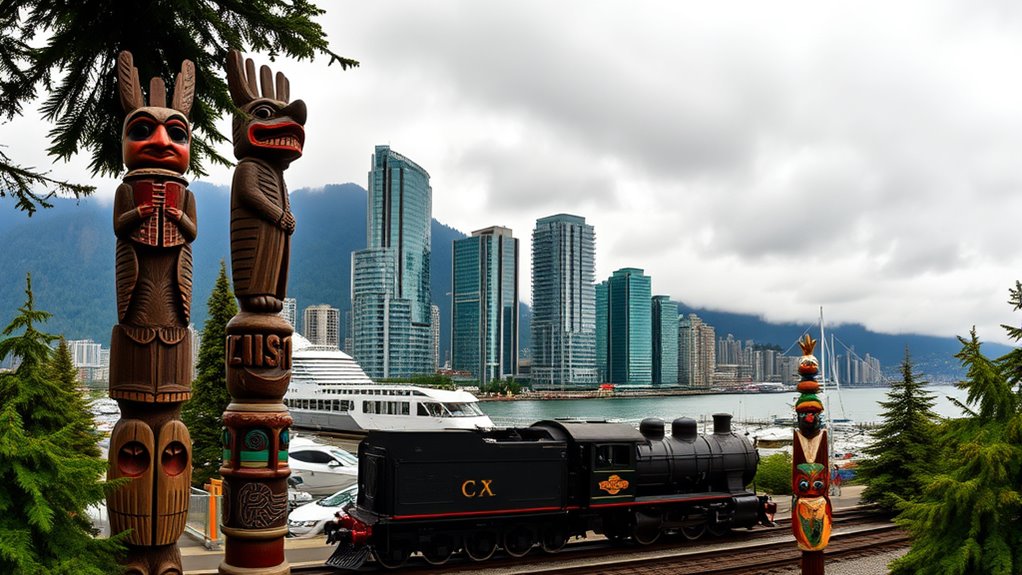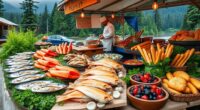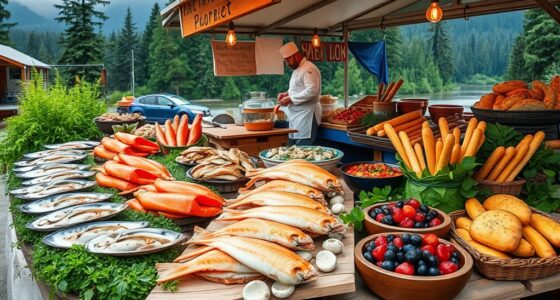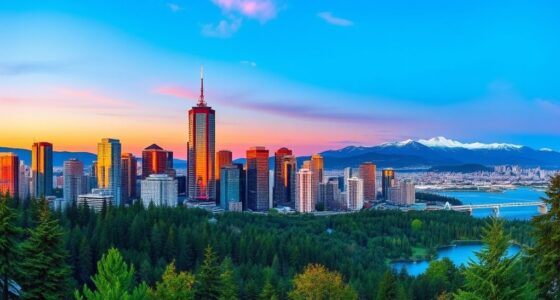British Columbia’s history and culture are shaped by Indigenous nations who have lived there for thousands of years, with rich traditions, languages, and environmental knowledge. European explorers like Cook and the fur trade brought new influences, leading to settlement and economic growth. Today, BC celebrates a diverse society, blending Indigenous revival, multicultural communities, and modern innovations. If you explore further, you’ll discover how these layers create BC’s vibrant identity and ongoing story.
Key Takeaways
- Indigenous peoples have inhabited BC for thousands of years, maintaining rich cultures, languages, and spiritual ties to the land.
- European exploration in the 16th and 18th centuries initiated territorial disputes and laid the groundwork for colonial settlements.
- The fur trade, established in the 19th century, was vital to BC’s early economy and linked Indigenous knowledge with global markets.
- Major events like gold rushes and railway development fueled economic growth, infrastructure, and population expansion in BC.
- Contemporary BC celebrates Indigenous cultural revival, diversity, and history through art, ceremonies, and efforts for land and sovereignty rights.
Indigenous Nations and Their Historical Roots
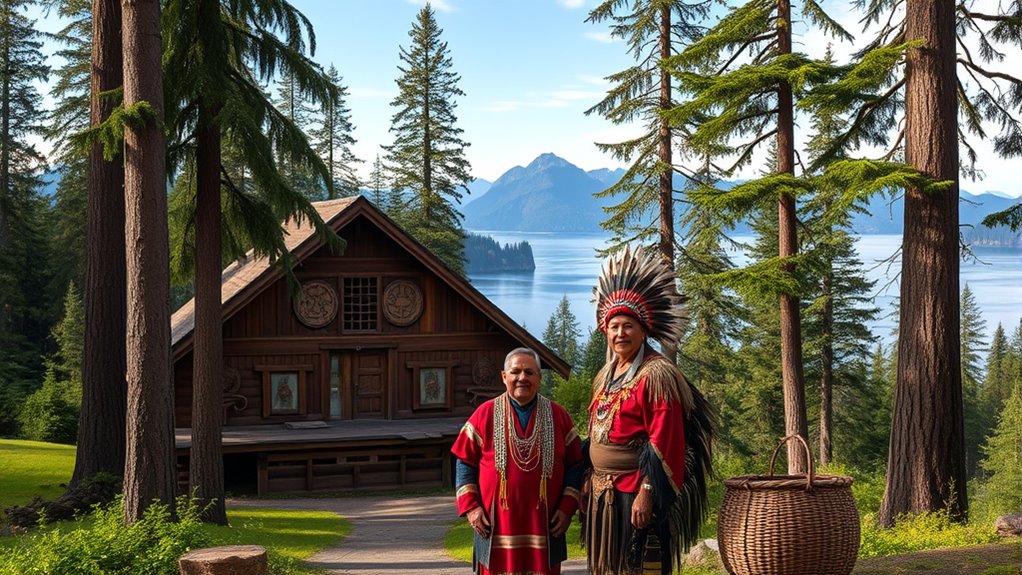
Indigenous Nations have inhabited British Columbia for thousands of years, developing rich cultures, complex social structures, and deep connections to the land. You can see evidence of their history in the vibrant art, traditions, and stories passed down through generations. Each Nation has its own language, customs, and spiritual beliefs tied closely to specific territories. Their relationship with the land shaped everything from hunting and fishing practices to governance and social organization. Before European contact, Indigenous peoples thrived in villages along coastlines, rivers, and mountains, managing resources sustainably. Their deep knowledge of the environment allowed them to adapt and flourish for millennia. Recognizing this enduring presence helps you understand the foundational role Indigenous Nations played in shaping the history and identity of British Columbia. Resource management was integral to their sustainable living practices and cultural continuity.
European Exploration and Early Encounters
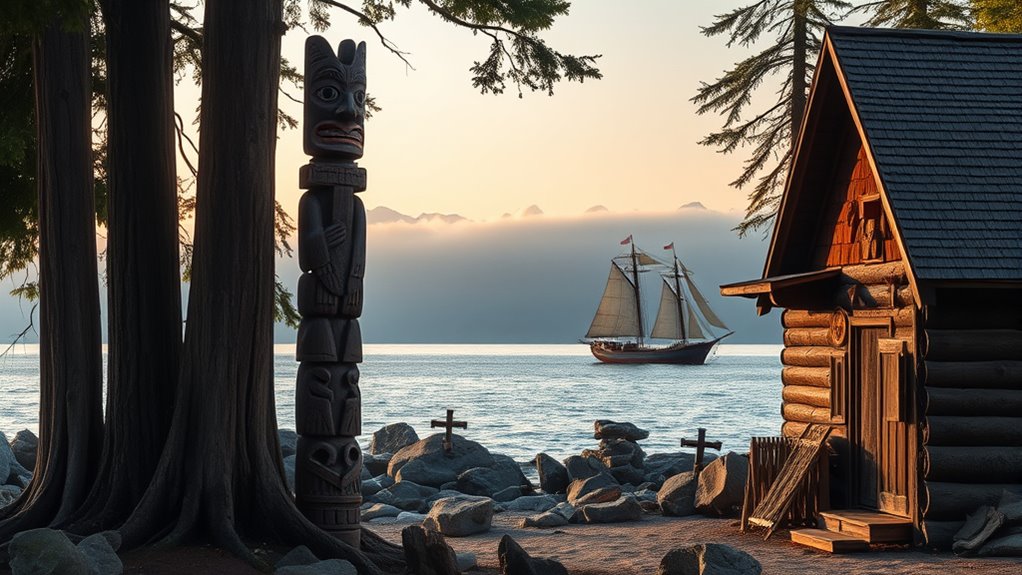
When Europeans first arrive along the coast, they encounter Indigenous nations with rich cultures and established territories. These early contacts often led to territorial disputes, which were eventually resolved through agreements like the Nootka Convention. The fur trade became the foundation of European presence, shaping the region’s early development and relationships. Additionally, European exploration strategies played a significant role in shaping the interactions and subsequent settlement patterns in British Columbia.
First European Contacts
European exploration of British Columbia began in the late 16th century, with explorers like Sir Francis Drake possibly sighting Vancouver Island in 1579. You might imagine the thrill of early sailors spotting uncharted coastlines and indigenous villages. In 1778, Captain James Cook arrived, making first contact with Coast Salish and Nuu-chah-nulth peoples. Spanish explorers at Nootka Sound in 1789 sparked territorial disputes that led to the Nootka Convention of 1790. These encounters introduced Europeans to the region’s rich Indigenous cultures, though often with conflict and misunderstandings. The region’s European exploration significantly impacted the development and recognition of British Columbia’s diverse cultural heritage. The table below highlights key explorers and events:
| Year | Event |
|---|---|
| 1579 | Drake’s possible sighting of Vancouver Island |
| 1778 | Cook’s arrival and first contact |
| 1789 | Spanish at Nootka Sound |
| 1790 | Nootka Convention |
| 1843 | Hudson’s Bay Fort Victoria founded |
Territorial Disputes Resolved
During the late 18th century, competing European powers actively staked claims to the Pacific Northwest, leading to conflicts over territory. You see, Spain and Britain clashed over land, especially around Nootka Sound, where Spain established a fort in 1789. This sparked the Nootka Convention in 1790, which peacefully resolved their disputes by recognizing British rights to the coast and Spain’s claims elsewhere. Later, the Treaty of Oregon in 1846 set the boundary at the 49th parallel, dividing territory between the U.S. and Britain. These agreements ended open conflicts, clarifying borders and preventing future disputes. As a result, British Columbia’s borders became stable, enabling colonization and development to proceed without ongoing territorial conflicts. Additionally, the recognition of territorial claims helped foster peaceful relations and facilitated regional growth.
Fur Trade Foundations
The early encounters between European explorers and the indigenous peoples of British Columbia laid the groundwork for the region’s fur trade economy. When explorers like Sir Francis Drake and Captain James Cook arrived, they made contact with Indigenous nations who had long relied on trapping and fishing. These interactions led to trade relationships, with Indigenous peoples supplying furs, especially sea otters, to European traders. The establishment of forts, such as Hudson’s Bay Company’s Fort Victoria in 1843, signaled the start of organized fur trading. European nations, mainly Britain and Spain, negotiated boundaries and territorial claims, shaping the region’s economic and political landscape. This early trade laid the foundation for British Columbia’s later development, linking Indigenous knowledge and resources with global markets.
The Birth of Colonial Settlements and Governance
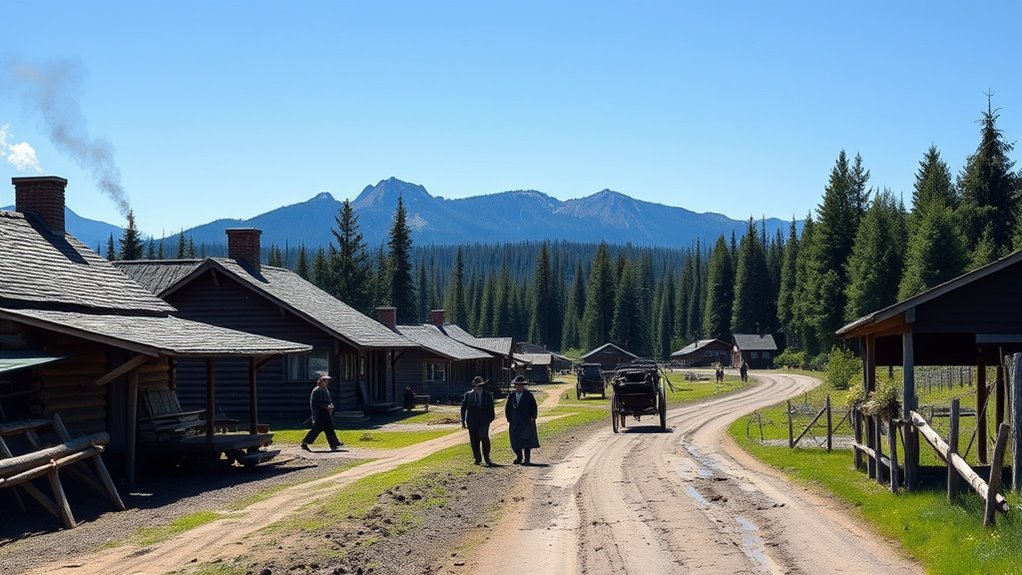
Colonial settlements in British Columbia began to take shape as European powers and traders established strategic outposts along the coast and inland. The Hudson’s Bay Company founded Fort Victoria in 1843, creating a hub for fur trade and settlement. In 1849, the Colony of Vancouver Island was officially established with Victoria as its capital. As gold rushes in 1858 spurred rapid population growth, Britain responded by creating the mainland colony of British Columbia. These colonies united in 1866 under a single government led by James Douglas, who balanced colonial interests and Crown authority. Local land policies favored European settlement and resource extraction, often at the expense of Indigenous lands. Colonial governance laid the foundation for political structures, setting the stage for British Columbia’s future development. The introduction of colonial administration further shaped the governance and societal organization during this period.
Confederation and the Building of the Transcontinental Railway

The transcontinental railway was essential for connecting British Columbia to eastern Canada, boosting trade and national unity. You should recognize the critical role Chinese laborers played in completing the railway, often facing harsh conditions and discrimination. This massive project spurred economic growth, opening new resources and markets that transformed B.C.’s development. Additionally, the project highlighted the importance of celebrity transformations in shaping public perceptions of resilience and adaptation during challenging times.
Railway’s Strategic Importance
Because connecting British Columbia to the rest of Canada was essential for economic development and national unity, building the transcontinental railway became a top priority after B.C. joined Confederation in 1871. The railway linked the coast to eastern Canada, opening new markets and facilitating trade. It also strengthened Canada’s claim to western territories, preventing U.S. expansion. The Canadian government saw the railway as crucial for integrating the vast region into the national economy. Without it, B.C. risked isolation and economic stagnation. The railway enabled resource exports, like timber, minerals, and fish, fueling growth. It also encouraged settlement and development of remote areas, shaping B.C.’s future as a key part of Canada. The railway’s strategic importance transformed B.C. from a distant frontier into a connected, thriving province. Furthermore, the project promoted interprovincial connectivity, which was vital for unifying the country and supporting its economic ambitions.
Chinese Labor Contributions
Building the transcontinental railway relied heavily on Chinese laborers, who played an indispensable role in completing this monumental project. About 15,000 Chinese workers contributed, facing harsh conditions, dangerous work, and racial discrimination. They worked tirelessly on the challenging terrain, often doing the most dangerous tasks like blasting through mountains and laying track in remote areas. Despite their vital contributions, they received lower wages and fewer protections than their white counterparts. Many Chinese workers endured injuries and fatalities—around 600 lives lost—yet their efforts helped connect British Columbia to the rest of Canada. Their labor was essential in overcoming the logistical and physical obstacles of the railway’s construction, shaping the development and integration of the region into the national fabric. The impact of their work extended beyond mere transportation, fostering economic growth and cultural diversity in the region.
Economic Impact Growth
Joining British Columbia to eastern Canada through the transcontinental railway sparked a significant boost in the region’s economy. The railway opened new markets for resource exports like timber, minerals, and fish, fueling industrial growth. It also attracted settlers, entrepreneurs, and workers, increasing population and development in towns along the route. The construction, especially the labor of Chinese workers, reduced transportation costs and connected BC to the rest of the country, making trade easier. This infrastructure project helped establish a unified economy, encouraging investment and resource exploitation. As a result, BC’s economy expanded rapidly, laying the foundation for modern industries. The railway’s completion in 1885 marked a turning point, transforming BC into a crucial part of Canada’s economic landscape.
Economic Boom: Gold Rushes and Natural Resources

The discovery of gold in British Columbia sparked a series of rapid economic growth and development that forever shaped the province’s future. You see, the Cariboo Gold Rush of the 1860s drew thousands of prospectors seeking fortune, leading to booming towns and infrastructure like the Cariboo Road. As gold discoveries continued, natural resources such as minerals, fish, and forests became essential economic drivers. The Fraser River’s salmon fisheries grew into a major industry, supporting local communities. Later, large-scale projects like aluminum smelters, pipelines, and gas facilities diversified the economy. Control over these resources shifted to provincial authorities by the 1930s, allowing B.C. to harness its natural wealth for sustained growth. This resource-driven boom laid the foundation for the province’s economic strength today.
Development of Fisheries and Industrial Growth

You see how the salmon industry expanded alongside British Columbia’s growth, becoming a cornerstone of the economy. As mineral discoveries sparked resource booms, infrastructure like roads and railways connected markets and supported industry. These developments fueled industrial growth and integrated B.C. into broader trade networks, transforming its economic landscape. Additionally, the development of fishing industry played a vital role in shaping the province’s economic identity.
Salmon Industry Expansion
Have you ever wondered how British Columbia’s salmon industry became a cornerstone of its economy? It all began with Indigenous peoples relying on salmon as a crucial food source for thousands of years. When European settlers arrived, they quickly recognized the fishery’s potential, expanding fishing methods and establishing canneries in the late 19th century. The industry grew rapidly during the early 20th century, driven by technological advances like steam-powered boats and improved canning techniques. As demand increased, commercial fisheries expanded along the coast, creating jobs and supporting local communities. Salmon became a key export product, fueling economic development and infrastructure growth. This expansion laid the foundation for British Columbia’s reputation as a major player in global fisheries, shaping its economic landscape for generations.
Mineral and Resource Boom
As British Columbia’s salmon industry expanded, the region’s natural resources caught the attention of prospectors and entrepreneurs enthusiastic to tap into its wealth. You quickly realize that this resource boom spurred rapid industrial growth, from mining to forestry. Mines like Sullivan (1892) accessed valuable lead-zinc-silver deposits, fueling economic expansion. Fisheries thrived, especially on the Fraser River, becoming essential to local livelihoods. The resource sector’s growth led to infrastructure projects such as railways and pipelines, connecting remote areas to markets. Below is a table highlighting key resource industries:
| Industry | Key Development | Impact |
|---|---|---|
| Mining | Sullivan Mine, 1892 | Industrial growth, exports |
| Fisheries | Salmon industry, 1863 | Employment, trade |
| Oil & Gas | Trans-Mountain pipeline, 1953 | Energy supply, economic boost |
Infrastructure and Market Development
The development of fisheries and industry in British Columbia depended heavily on building infrastructure that connected remote resource-rich areas to markets. You see, roads, railways, and ports were essential for transporting fish, minerals, and timber efficiently. The Canadian Pacific Railway, completed in 1885, opened up the interior and coastal regions, allowing exports to flourish. Fish canneries and processing plants lined the coast, supported by improved shipping routes. Ports like Vancouver grew into major trade hubs, facilitating the movement of goods inland and abroad. Infrastructure projects also included pipelines and hydroelectric facilities, powering industries and enabling resource extraction. These developments transformed BC into a resource-driven economy, attracting investment, boosting exports, and fostering industrial growth, making the province a critical player in Canada’s overall economic landscape.
Social Movements and Cultural Revivals
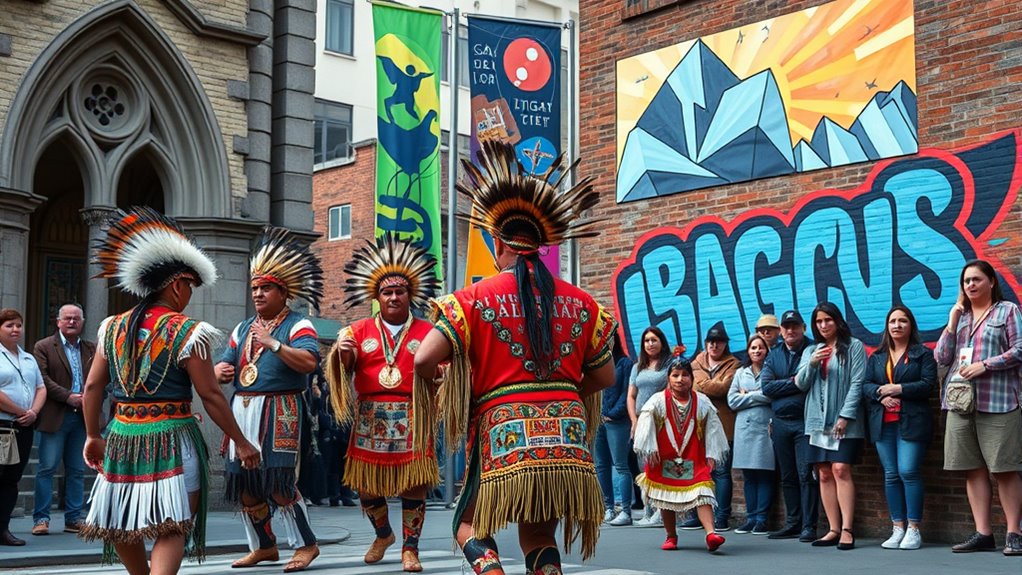
Social movements and cultural revivals in British Columbia have played a crucial role in shaping the province’s identity and advocating for marginalized groups. You witness Indigenous communities fighting for land rights, cultural recognition, and the preservation of traditions like potlatch ceremonies, which were once banned. Environmental advocates, like Greenpeace, have pushed for conservation and sustainable resource use, influencing policy and public awareness. You see immigrant communities celebrating their heritage through festivals and cultural centers, enriching BC’s diversity. Anti-discrimination campaigns have challenged inequality, fostering greater inclusion. These movements have empowered communities to reclaim their histories, assert their rights, and influence societal values. Together, they forge a vibrant, resilient culture that reflects BC’s complex history and ongoing quest for justice and cultural vitality.
Urban Expansion and Major International Events
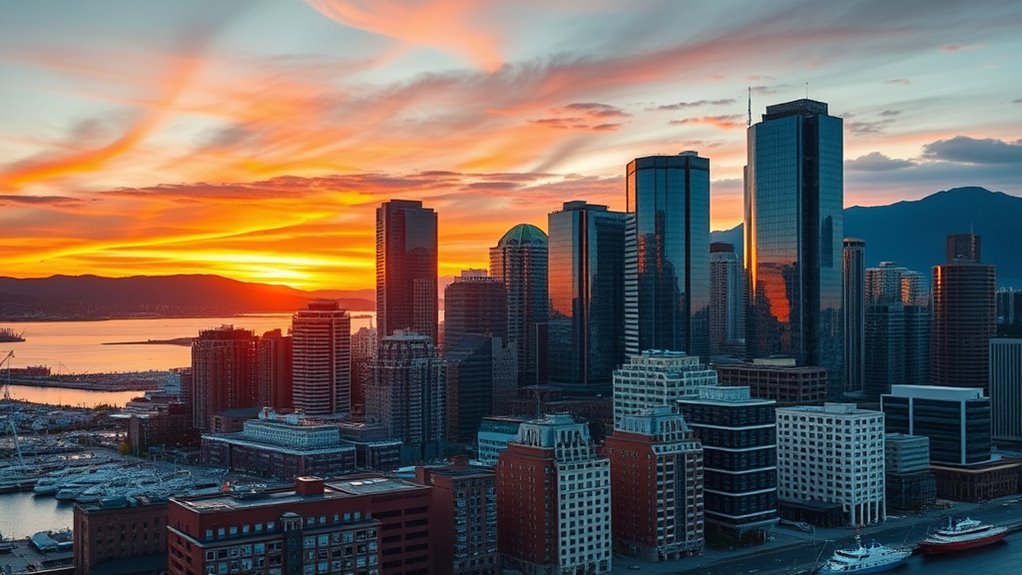
Have you ever wondered how Vancouver and other cities in British Columbia transformed into bustling urban centers? It all began with major international events and infrastructure projects. Here’s how the growth accelerated:
Major events and infrastructure projects transformed Vancouver into a thriving urban hub.
- The 1986 Expo in Vancouver showcased BC’s innovation, attracting global visitors and investments.
- The 2010 Winter Olympics in Vancouver brought worldwide attention, boosting tourism and infrastructure.
- Urban expansion occurred as neighborhoods like Yaletown and Granville Island developed into vibrant districts.
- International conferences and trade shows, such as the Asia-Pacific Economic Cooperation (APEC), helped position BC as a global hub.
These events and developments fueled population growth, modernized cityscapes, and strengthened BC’s global connections, shaping its vibrant urban landscape today.
Indigenous Rights and Cultural Resurgence
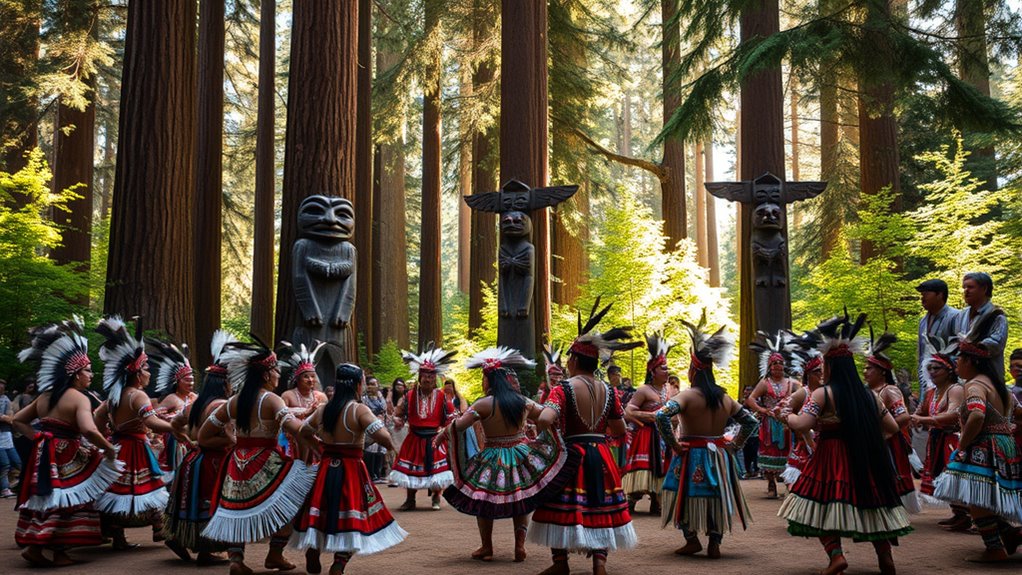
Major international events like Expo 86 and the 2010 Winter Olympics put British Columbia on the global stage, highlighting its diverse communities and vibrant cities. Yet, beneath this visibility, Indigenous peoples have fought tirelessly for recognition, land rights, and cultural revival. You see, their efforts have led to important legal victories and the revitalization of traditional practices like Potlatch ceremonies. Indigenous communities are reclaiming language, arts, and ceremonies once suppressed by colonial policies. Today, Indigenous leaders advocate for sovereignty, land restitution, and respectful partnership with the government. This cultural resurgence isn’t just about preserving history — it’s a powerful movement shaping BC’s identity, fostering pride, and ensuring Indigenous voices are heard and valued in the province’s ongoing story.
Modern BC: Diversity, Innovation, and Sustainability

How does modern British Columbia showcase its vibrant diversity, innovative spirit, and commitment to sustainability? You see it in action through:
- Multicultural communities that celebrate traditions from Asia, Europe, and Indigenous nations, enriching BC’s cultural landscape.
- Green technology initiatives, like renewable energy projects and eco-friendly urban planning, reducing environmental impact.
- Indigenous-led conservation efforts that blend traditional knowledge with modern sustainability practices.
- Innovative industries, including clean tech startups, film production, and sustainable forestry, driving economic growth while respecting nature.
BC’s focus on inclusivity, environmental responsibility, and innovation keeps it at the forefront of a modern, diverse society, balancing progress with preservation.
Frequently Asked Questions
How Did Indigenous Land Rights Influence British Columbia’s History?
Your understanding of Indigenous land rights reveals how they shaped BC’s history. You see how Indigenous Nations fought for recognition and redress, influencing land policies and political activism. Their ongoing efforts to reclaim land and preserve culture challenged colonial authorities, leading to legal battles and social change. Recognizing these rights helped shape policies, fostered reconciliation, and remains central to BC’s cultural identity and ongoing development.
What Role Did Chinese Laborers Play in Building the Railway?
Like the brave workers who built the Great Wall, Chinese laborers played a crucial role in constructing the Canadian Pacific Railway. You might not realize they made up about 15,000 of the workforce, facing dangerous conditions and discrimination. Their hard work connected East and West, enabling Canada’s expansion. Sadly, roughly 600 of these workers lost their lives, yet their efforts laid the foundation for British Columbia’s growth and integration into Canada.
How Have Immigration Waves Shaped Bc’s Cultural Landscape?
You see that immigration waves have deeply shaped BC’s cultural landscape by bringing diverse communities, especially Asian, European, and Indigenous populations. These groups have contributed to the province’s social fabric, economy, and cultural traditions. You experience this diversity in local festivals, cuisines, languages, and cultural practices. Immigration has fostered vibrant multicultural neighborhoods and influenced policies, making BC a dynamic, inclusive place where different cultures coexist and enrich the provincial identity.
What Are the Lasting Impacts of Residential Schools on Indigenous Communities?
You see that residential schools have left lasting scars on Indigenous communities, including trauma, loss of language, and cultural disconnection. Many community members struggle with intergenerational effects like mental health issues and mistrust towards institutions. Despite efforts to heal and reclaim traditions, the legacy of these schools continues to impact relationships, identity, and well-being, making reconciliation an ongoing process that requires acknowledgment, respect, and support for Indigenous sovereignty.
How Is BC Addressing Environmental Sustainability Today?
You see BC planting seeds for a greener future, weaving sustainability into every thread. The province invests in renewable energy, protects crucial ecosystems, and champions Indigenous-led conservation efforts. Policies aim to turn the tide on climate change, fostering a balance between progress and preservation. You’re part of this movement, helping BC grow into a resilient landscape where nature and community thrive side by side, like a symphony in harmony.
Conclusion
You’ve uncovered the incredible tapestry of British Columbia’s history and culture, a story as vast and vibrant as the mountains themselves. From Indigenous roots to modern innovations, BC’s journey is a testament to resilience and diversity. As you explore its rich past, remember that this province’s spirit shines brighter than a thousand sunsets, forever shaping its future. Embrace its story, and you’ll see a land that’s truly a masterpiece of human and natural wonder.

